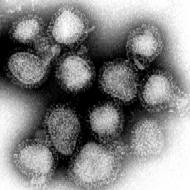Influenza A virus subtype H3N2
Influenza A virus subtype H3N2 (A/H3N2) is a subtype of viruses that causes influenza (flu). H3N2 viruses can infect birds and mammals. In birds, humans, and pigs, the virus has mutated into many strains. In years in which H3N2 is the predominant strain, there are more hospitalizations.[1]
H3N2 is a subtype of the viral genus Influenzavirus A, which is an important cause of human influenza. Its name derives from the forms of the two kinds of proteins on the surface of its coat, hemagglutinin (H) and neuraminidase (N). By reassortment, H3N2 exchanges genes for internal proteins with other influenza subtypes.[citation needed]
Seasonal influenza kills an estimated 36,000 people in the United States each year. Flu vaccines are based on predicting which "mutants" of H1N1, H3N2, H1N2, and influenza B will proliferate in the next season. Separate vaccines are developed for the Northern and Southern Hemispheres in preparation for their annual epidemics. In the tropics, influenza shows no clear seasonality. In the past ten years, H3N2 has tended to dominate in prevalence over H1N1, H1N2, and influenza B. Measured resistance to the standard antiviral drugs amantadine and rimantadine in H3N2 has increased from 1% in 1994 to 12% in 2003 to 91% in 2005.[2]
Seasonal H3N2 flu is a human flu from H3N2 that is slightly different from one of the previous year's flu season H3N2 variants. Seasonal influenza viruses flow out of overlapping epidemics in East Asia and Southeast Asia, then trickle around the globe before dying off. Identifying the source of the viruses allows global health officials to better predict which viruses are most likely to cause the most disease over the next year. An analysis of 13,000 samples of influenza A/H3N2 virus that were collected across six continents from 2002 to 2007 by the WHO's Global Influenza Surveillance Network showed the newly emerging strains of H3N2 appeared in East and Southeast Asian countries about six to nine months earlier than anywhere else. The strains generally reached Australia and New Zealand next, followed by North America and Europe. The new variants typically reached South America after an additional six to nine months, the group reported.[3]
A 2007 study reported: "In swine, three influenza A virus subtypes (H1N1, H3N2, and H1N2) are circulating throughout the world. In the United States, the classic H1N1 subtype was exclusively prevalent among swine populations before 1998; however, since late August 1998, H3N2 subtypes have been isolated from pigs. Most H3N2 virus isolates are triple reassortants, containing genes from human (HA, NA, and PB1), swine (NS, NP, and M), and avian (PB2 and PA) lineages. Present vaccination strategies for swine influenza virus (SIV) control and prevention in swine farms typically include the use of one of several bivalent SIV vaccines commercially available in the United States. Of the 97 recent H3N2 isolates examined, only 41 had strong serologic cross-reactions with antiserum to three commercial SIV vaccines. Since the protective ability of influenza vaccines depends primarily on the closeness of the match between the vaccine virus and the epidemic virus, the presence of nonreactive H3N2 SIV variants suggests current commercial vaccines might not effectively protect pigs from infection with a majority of H3N2 viruses."[4]


